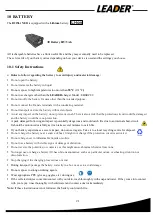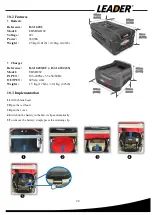
23
10.4
Storage
▪
Avoid any exposure to direct sunlight, high temperatures, or excessive humidity levels.
▪
Store in a dry place, at temperatures
-15°C
(5°F)
à 40°C
(104°F).
Storing the battery at humidity can permanently damage the battery: corrosion of metal parts, swelling, and
leakage...
If you plan to store the battery for a long period (more than 30 days), with a capacity between 30% and 50%.
A maintenance charge should take place once every 2 months to avoid deterioration.
▪
Avoid storing in electrostatically charged areas.
▪
Do not store together with electro-conductive material.
10.5
Battery Treatment
Discarding batteries directly in the garbage greatly harms the environment.
Do not throw batteries away just anywhere; limit any risk of pollution and avoid contaminating nature with the
traces of heavy metals still contained in certain types of batteries.
Batteries are collected and reprocessed; they contain certain recoverable heavy metals.
Deposit them in designated areas (recycling centres, collection points...).
LEADER
joins
RECYLUM
for the recycling of its
WEEE
(Waste electrical and electronic equipment).
10.6
Transport
Lithium batteries are considered hazardous products and are subject to regulations. Contact your carrier
before shipment.
11
TROUBLESHOOTING
Problem
What to do
The fan does not work
•
Check that the battery is correctly engaged.
•
Check that the battery is charged (control panel LED status).
•
See LED status description
(P7).
The battery will not charge
•
Check that the battery is correctly engaged.
•
Check that there is a good power supply.
•
Check that the room temperature is between
+6 and +40°C
(43°F and 104°F).
•
See LED status description
(P7).
The fan lacks autonomy
•
Check that the battery is charged (control panel LED status).
•
See LED status description
(P7).
Note :
Over time and the charge cycles, the battery will lose its autonomy.
12
SPARE PARTS
To identify your
B215 Li NEO
parts, please contact us.
















































